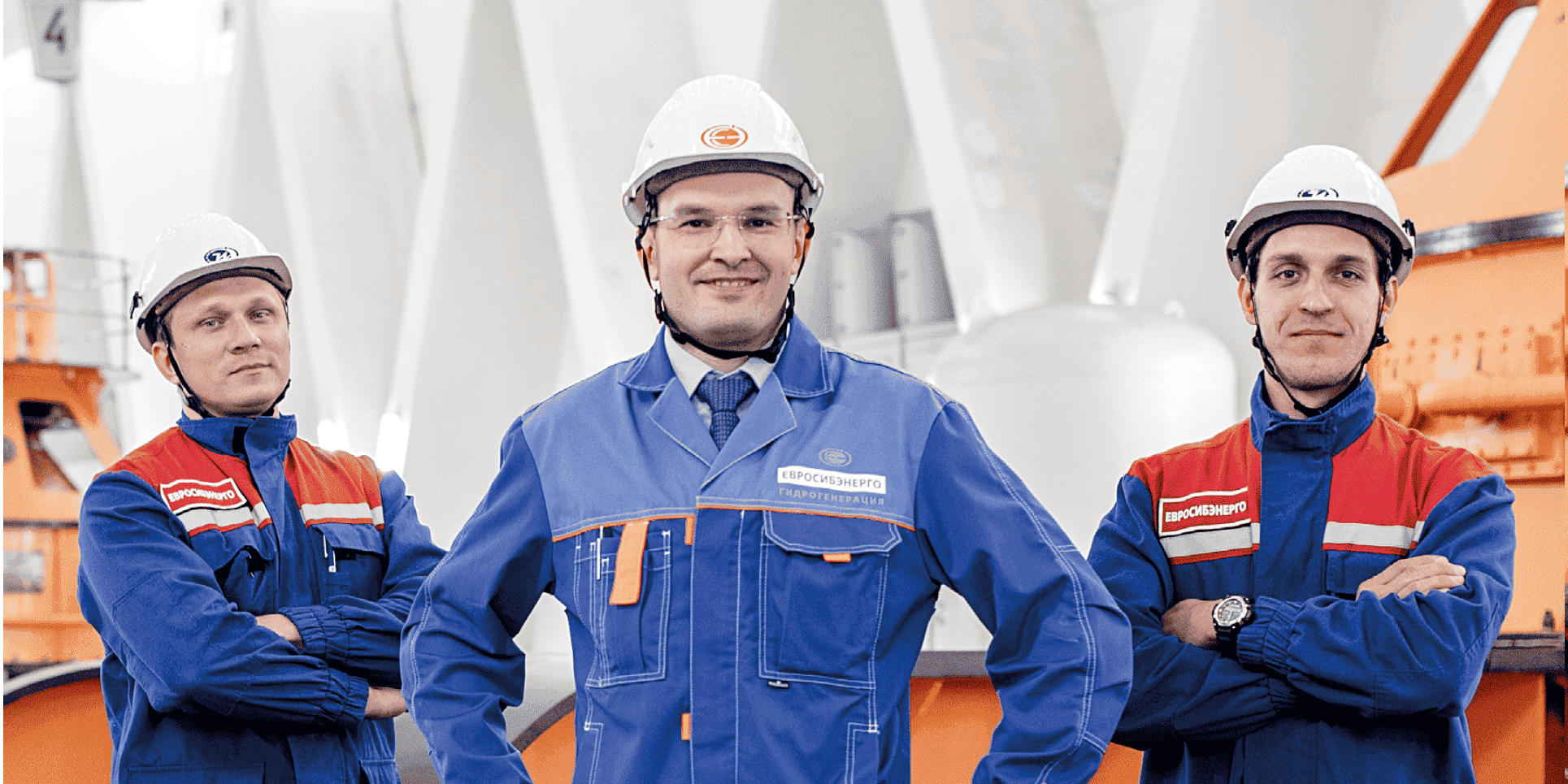Occupational health and safety
- Health, Occupational, Industrial and Fire Safety Policy
- Regulations on the Health, Safety and Environment Committee
- Regulations on the Occupational Safety Committee
Material topic
- Occupational health and safety

GRI 3‑3, 403‑1, 403‑2, 403‑4, 403‑8, 14.16.1, 14.16.2, 14.16.3, 14.16.5, 14.16.9
People are a key asset of En+ Group. The Company’s main goal is to reduce the overall injury rate and achieve zero fatalities.
To meet this goal, the Group focuses on fostering a robust safety culture among its employees, boosting their competencies, preventing accidents and injuries, while minimising the impact of occupational hazards.
The Company has established an occupational health and safety (OHS) management system that encompasses all employees and contractors. When developing and updating its corporate OHS documents, the Group is guided by current requirements of national regulations, international standards, and best industry practices.
En+ Group’s basic principles and responsibilities are set out in its Health, Occupational, Industrial, and Fire Safety Policy that establishes the right of each employee to decline work that poses a threat to their life and health. According to the document, the CEO should promote the implementation of the Policy’s objectives and demonstrate a personal commitment to occupational safety.
The Company places considerable importance on the confirmation that its OHS management system complies with ISO 45001:2018. All production units of the Power segment have valid certificates of compliance with this standard. In the Metals segment, 12 enterprises have such certificates, and part of them were recertified in 2024. In 2024, all certified enterprises underwent external supervisory audits that confirmed their compliance with the said standard. The Group also conducts annual internal audits of the system. Over the past year, the OHS Department arranged 24 on‑site audit visits. To improve communication with employees during on‑site inspections, behavioural safety audits (BSAs) are also undertaken.
GRI 2‑13
OHS management structure
The Health, Safety, and Environment Committee assesses the efficiency and effectiveness of En+ Group’s OHS management on a quarterly basis. As a result of the analysis, the Committee makes recommendations to the Board of Directors concerning the approval of OHS goals, policies, and strategies.
For more details on En+ Group’s Health, Safety, and Environment Committee and its performance, see the Corporate Governance section
To improve the efficiency of the OHS management system, establish communication channels between functions and directorates, and enhance safety culture, the Occupational Safety Committee has been established in the Power segment. During 2024, the Committee held ten meetings where the following issues were considered:
- Occupational safety goals for 2024
- Findings of investigations into accidents and hazardous situations
- Progress in implementing the strategic occupational safety plan
- Results of comprehensive and special‑purpose inspections of occupational safety at branches
- Analysis of employee survey results concerning their satisfaction with the quality of personal protective equipment (PPE)
- Analysis of the Safety Plus employee survey devoted to safety culture aspects
- Best industrial safety practices offered by branches and their rollout at all enterprises
- Takeaways from the World Day for Safety and Health at Work
- Factor analysis of injuries
- Results of the Safety Leader competition, etc.
The OHS Department coordinates the functioning of the system. The duties of the Department include:
- Boosting specialist competencies and managing OHS functions at enterprises
- Conducting internal audits of the OHS management system at enterprises
- Enhancing the efficiency of communication with employees, including through BSAs
- Employee training
Contractor management
GRI 403‑1, 403‑2, 403‑5, 403‑7, 14.16.2, 14.16.3, 14.16.6, 14.16.8
En+ Group strives to ensure the safety of not only its own employees, but also those of contractors who perform work for the Company.
In 2024, the Regulations on the Contractor Safety Management were approved in Power segment. These Regulations describe safety requirements for contractors. The Regulations are aimed at ensuring the safety of both contractors and the Company’s own employees when contractors work on the Company’s premises.
The Agreement for Occupational Health, Industrial, and Fire Safety, that is included in all contracts with suppliers, outlines the OHS obligations and responsibilities of contractors. Each contractor receives an induction briefing before being permitted to work at En+ Group’s facilities. The OHS team informs contractors about corporate safety requirements, necessary PPE, and potential risks inherent in the Group’s operations.
To monitor the safety of contractors, En+ Group conducts comprehensive on‑site audits, special‑purpose and surprise inspections. In 2024, most common violations included violations committed when working at height, issuing safe work permits, and preparing the work site, as well as failure to use PPE, failure to follow the standard operating procedure, and non‑compliance with safety signs.
To minimise OHS violations among contractors, the Company conducts BSAs and holds meetings and consultations with contractors’ managers, OHS departments, and employees. Leveraging a risk‑based approach commensurate with the nature of the performed work, the Company provides additional training to contractors. For example, heads of OHS departments of the Power segment’s contractors received a two‑days’ training at a safety coaching session in 2024.
The Metals segment applies the principle of collective responsibility in case of violations of OHS requirements by contractors: the entire team is suspended from work and receives unscheduled briefings and training.

The Power segment is implementing the Strategic Action Plan for 2024–2026 that has been developed as a result of an external safety culture audit conducted in 2023.
To achieve a 50% reduction in work‑related injury rates and critical occupational accidents and eliminate fatal injuries, the Metals segment is pursuing the Occupational Health and Safety Strategy to 2030. This Strategy includes the Safety Culture project designed to assess employees’ unsafe behaviour, make line managers, middle and senior managers aware of the psychological aspects of safe behaviour, and develop their leadership competencies.
Safety culture
GRI 403‑2, 403‑4, 14.16.3, 14.16.5
En+ Group implements various measures to enhance its safety culture, including:
- The practice of conducting BSAs to help the Company monitor the behaviour of employees during process operations and develop their safe work habits, which subsequently reduces the impact of the human factor on the incident rate.
- Coaching sessions with managers across various levels to foster their commitment to occupational safety.
- The practice of video recording of meetings to control the quality of OHS briefings and the efficiency of communication between employees and their line managers. Such communication includes mandatory five‑minute reports on injuries or existing injury risks to be given at each meeting by line managers.
Health protection
GRI 2‑25, 403‑3, 403‑6, 403‑10, 14.16.4, 14.16.7, 14.16.11

In 2024, the Company launched a cancer screening programme at its industrial facilities in Shelekhov and Krasnoyarsk. 1,254 employees took part in the programme. The Company arranged surgical treatment of two employees with early‑stage malignant tumours.
The project is aimed at increasing the availability of healthcare services in remote regions. In 2024, the Company expanded the list of healthcare professionals temporarily employed in regions with a pronounced shortage of doctors. This has multiplied the total number of patient visits. Both employees and their family members and local people are able to receive medical treatment. In two towns, patients are able to arrange a medical appointment with highly specialised children’s doctors.
For more details on En+ Group’s sporting events, see the Contribution to Local Communities, section, and on the Company’s VMI programme, see the Employees section
The Company organises regular advanced training for in‑house healthcare professionals and engages other qualified medical care providers. All health data is collected and stored in accordance with statutory requirements and transmitted via secure communication channels.
The Company has 11 own healthcare centres, regularly opens new healthcare facilities and repairs/renovates existing ones. In January 2025, a medical aid post was opened at the industrial site in the village of Startsevo, Emelyanovsky District, Krasnoyarsk Territory. Moreover, repairs were carried out on medical centers in Krasnoturinsk, Shelekhov, Sayanogorsk, and Achinsk. In addition to general health promotion, such measures help the Company detect occupational diseases at an early stage and initiate prompt treatment thus preventing health deterioration.
OHS training

In the reporting period, the Metals segment launched the Basics of Safe Behaviour project. The initiative focuses on employees’ psycho‑physiological state which could increase the risk of dangerous actions. The relevant training course for employees was launched on an online platform. The Company expects that the project will help employees develop useful habits for protecting their life and health and the skill of analysing their own state before performing work that requires caution and attention.
GRI 403‑5, 14.16.6
En+ Group conducts regular mandatory training for employees in occupational health and safety, fire safety, civil defence, emergency prevention and response. The Group has established Basic and Principal Safety Rules that are regularly communicated to employees and contractors during briefings and meetings.
Moreover, the Company holds additional training sessions depending on its goals and objectives for the current period. Employees receive training in‑house and in external training centres.
Upon completion of a training course, trainees undergo knowledge assessments and provide feedback through post‑training satisfaction surveys, enabling En+ Group to evaluate training effectiveness and the need to improve training programmes. HR specialists monitor timely provision of training under each programme.
In 2024, the Power segment developed and implemented a matrix of mandatory types of employee training and certification for each job and profession. In the reporting period, the Metals segment included workplace safety cases in its training programmes for the talent pool of managers.
Emergency preparedness
GRI 3‑3, 403‑2, 403‑7, 14.15.1, 14.15.3, 14.15.4
Because of the specifics of En+ Group’s operations and location of its production sites, the Company is exposed to the risk of natural and man‑made emergencies, accidents and incidents at hazardous industrial facilities and hydraulic structures.
The Company has developed Emergency Response Plans for all hazardous industrial facilities and coordinated them with representatives of state supervisory body. These Plans outline key emergency risks and response strategies. For all facilities at risk of petroleum product spills, En+ Group has formulated Spill Prevention, Control, and Countermeasure (SPCC) Plans that have been approved by supervisory authorities.
All employees working at the relevant industrial facilities are required to familiarise themselves with these documents. Based on these Plans, exercises and drills are held with the involvement of fire‑rescue and emergency response teams and representatives of state supervisory bodies, such as the Russian Ministry of Energy, Ministry of Emergency Situations, and the Federal Environmental, Industrial, and Nuclear Supervision Service of Russia (Rostechnadzor). For example, in 2024, the Company conducted drills on remediating the consequences of an emergency caused by an interruption of heat and hot water supply. In 2024, En+ Group started to review existing and introduce new civil defence training programmes and methods for the population, officials, and employees, and focused on bringing civil defence protective structures into proper condition and preparing measures to evacuate employees from potential emergency zones to safe areas.
To prevent emergencies and reduce their adverse consequences, the Company maintains the functionality and modernises local warning systems, and also integrates them with municipal warning systems.
GRI 413‑1
En+ Group has established a system to share emergency‑related data at the emergency forecasting phase and in case of its actual occurrence. A dedicated hotline is used to receive information from employees and third parties. For emergency alerts, the Company’s enterprises use local warning systems that are integrated with municipal alert mechanisms.
GRI 14.15.1
To prevent industrial accidents and incidents that may be caused by the operation of hazardous production facilities, En+ Group ensures maintenance, industrial safety reviewsIndustrial safety requirements, including those related to the preparation and performance of industrial safety reviews, are set out in the Group’s local documents., upgrades, and overhauls of equipment, buildings, and structures, implements modern operational practices, and uses advanced operation, maintenance, and repair technologies.

In 2024, an industrial safety working group consisting of 15 employees was created at the Metals segment. The objectives of the group are to identify accident and incident risks at hazardous industrial facilities, develop measures to prevent them, and find opportunities for improving the industrial safety management system. In the reporting period, the working group focused on enhancing the safety of mining operations: checklists were developed to inspect hazardous industrial facilities, and facility audits were performed.
GRI 3‑3, 403‑2, 403‑4, 403‑9, 14.16.1, 14.16.3, 14.16.5, 14.16.10
The risk‑based approach underlying the Group’s OHS management system allows for proactive risk management strategies to ensure employee safety. En+ Group’s enterprises apply corporate safety risk assessment procedures. The Group adopts preventive measures to reduce risk levels and takes actions developed as a result of accident investigations.
Avoidance of hazardous operations, elimination of hazards
Replacement of hazardous operations, equipment, and materials
Technical methods to reduce the impact of hazards on employees
Organisational methods to reduce the time of employees’ exposure to hazards
Administrative methods (training sessions, briefings, technical courses, audits, etc.)
Collective and personal protective equipment
Professional indemnity insurance
Since PPE is the final physical barrier between harmful and hazardous workplace factors and employees, the Company pays great attention to the quality and range of PPE provided to employees. All PPE is provided to employees in accordance with their gender and anthropometric parameters.
As a result of conducted risk assessments and accident investigations and based on violations identified during internal audits, the Company has made a list of the most significant risks:
- Risk of employees falling when moving around the site and industrial premises of enterprises
- Risk of falling from a height
- Pinch point and caught‑between hazards when working with rotating and moving machines
- Caught‑in hazards when working near rotating parts of machines
- Risk of electric shock
- Risk of collapse of the roof of the mine due to the impact of a mining impact
Key OHS risks (process risks and safety such as natural disasters, large‑scale accidents, epidemics, etc.) are included in the consolidated list of sustainability risks at En+ Group and regularly analysed by the Group’s top management.
Undoubtedly, hazardous operations have the highest injury potential. Each enterprise has approved a list of hazardous operations. Supervisors in charge of relevant operations carry out a mandatory risk assessment and take measures to manage identified risks.
For more details on realised risks, injuries, accidents, incidents, and emergencies, see the Metrics and Targets subsection
Employees are also expected to identify unsafe conditions and actions before and during performing any operation. There are several communication channels for employees to report such actions/conditions to their line manager and OHS specialists so that they could take corrective measures:
- telephone and e‑mail
- telegram‑channels
- labour dispute commissions, OHS commissions, and ad‑hoc commissions
- monthly meetings on OHS issues
- the Signal hotline
- speak‑up boxes
- an incident warning system for managers
En+ Group conducts a special assessment of working conditions at least once every five yearsIn accordance with the classification provided in the Federal Law On Special Assessment of Working Conditions.. The most prevalent harmful workplace factors for the Power segment include occupational noise, heightened dust levels in working areas, and whole‑body vibration. In the Metals segment, harmful workplace factors are attributed to arduous work.
Occupational noise
- Protection by time – arrangement of the appropriate work and rest schedule
- Hearing protection equipment
Heightened dust levels in working areas
- Dust suppression and aspiration systems
- Respiratory protection equipment
Whole‑body vibration
- Appropriate work and rest schedule
- Replacement of driver seats in special vehicles with shock‑absorbing seats
Arduous work
- In‑process testing of exoskeletons is being carried out

| Goals | Status | Progress made in 2024 |
|---|---|---|
| Decrease LTIFR by 10% and achieve zero fatalities | Not achieved |
|
| Develop OHS digitalisation and automation projects | Achieved |
|
| Increase the percentage of enterprises whose OHS management systems comply with ISO:45001 | Achieved |
|
GRI 3‑3, 403‑1, 14.16.1, 14.16.2
The Company regularly reviews the results of external and internal audits of its OHS management system and tracks the achievement of safety goals and KPIs. In accordance with the Regulations on Ongoing OHS Status Monitoring, managers across all levels conduct monthly assessments of the prevalent OHS situation and report these data to OHS functions.
GRI 3‑3, 14.16.1
In 2024, KPIs of managers across all levels at the Power segment were supplemented with occupational safety indicators: zero fatal injuries, achievement of the Company’s target LTIFR, ISO 45001 certification, implementation of the strategic OHS action plan. As for the Metals segment, KPIs of business unit managers included the launch of projects to introduce occupational safety tools in addition to the implementation of measures to improve working conditions. The KPI achievement status is assessed annually and affects the remuneration of managers across all levels.
GRI 403‑2, 403‑9, 14.16.3, 14.16.10, SASB EM‑MM‑320a.1, IF‑EU‑320a.1
En+ Group registers and maintains records of work‑related injuries, accidents, and occupational diseases among both employees and contractors. The Company rigorously investigates each incident in compliance with effective legislation and local procedures. Based on the investigation results, causes of incidents are identified and measures to prevent such incidents in the future are developed.
GRI 403‑9, 14.16.10, SASB EM‑MM‑320a.1, IF‑EU‑320a.1
In total, the Company recorded 119 workplace accidents involving employees and 29 workplace accidents involving contractors in 2024. The most common types of occupational injuries are bruises, fractures, chemical (due to exposure to sodium hydroxide solution) and thermal burns in the Metals segment, and bruises, fractures, and thermal burns in the Power segment. A large portion of incidents was caused by falls, including falls from the same level, pinch point and caught‑between hazards, falling objects, contact with rotating parts and mechanisms.
In 2024, the main causes of occupational injuries included:
- Poor condition of stairs
- Littering and late cleaning of pathways from snow and ice
- Movement along an unauthorised route
- Lack of coordinated action when performing work
- Violation of the rules for placing machine parts and mechanisms
- Performance of hazardous operations without a safe work permit
- Staying in a hazardous area with rotating mechanisms
- Personal negligence
The causes of fatal and serious injuries included a rock fall, lack of control over the organisation and performance of operations by responsible persons and violation of safety requirements by the injured, inadequate work management.
In 2024, 7 employees and 4 contractors died as a result of occupational accidents at the Company’s facilities.
A group accident occurred at the Metals segment as a result of falling rock at a mine. One employee lost his life and the other was seriously injured. The Company improved its information support for research and identification of focal factors of rock bumps, adjusted the methodology for calculating the stability indicator, and arranged the development of earthquake‑resistant mine supports.
An employee of the Metals segment was fatally injured as a result of a collapse of metal structures. After this incident, the Company reconstructed all multi‑stage washers at the site to make them single‑stage washers, assessed the technical condition of all washers, and developed temperature control measures for possible admission of employees to the washer.
In the Power segment, a fatal accident occurred at one of open‑pit coal mines as a result of an employee being caught between rotating parts of production equipment. Following this incident, the Company installed additional guards for rotating mechanisms that prevent unauthorised access of employees to a hazardous area, inspected light and sound alarms, safety and locking devices on all equipment with rotating parts, and installed additional light alarms with a remote start function.
Another fatality occurred as a result of an unstable metal structure falling on an employee. Based on the investigation results, an action plan was developed that included the development of safe work maps with step‑by‑step descriptions for the manufacture of large‑size, same‑type metal structures.

En+ Group’s injury rates in 2024
GRI 403‑9, 14.16.10, SASB EM‑MM‑320a.1, IF‑EU‑320a.1
GRI 403‑9, 14.16.10, SASB EM‑MM‑320a.1, IF‑EU‑320a.1
GRI 403‑9, 14.16.10, SASB EM‑MM‑320a.1, IF‑EU‑320a.1
For more details on injury metrics and rates, see the Appendix Additional ESG Data
GRI 403‑10, 14.16.11
In 2024, the Group registered 228 cases of occupational disease. The prevalent occupational diseases are vibration syndrome at the Power segment and vibration syndrome, arthrosis, periarthrosis, and chronic fluorine intoxication at the Metals segment.
GRI 403‑10, 14.16.11, 14.15.3
No natural or man‑made emergencies occurred at En+ Group’s facilities in 2024.
Plans for 2025 and the medium term
- To commence full‑scale operation of the En+ Life application.
- To implement the Regulations on the Contractor Safety Management.
- To introduce a company‑wide system to analyse identified violations.
- To review the BSA process.
- To learn lessons from occupational safety incidents and apply the insights at all enterprises.
- To arrange dental care for employees – a pilot project at Krasnoyarsk HPP.
- To organise rehabilitation for operational staff of enterprises in case of emotional burnout and psychological difficulties.
